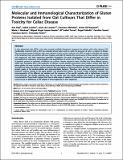Por favor, use este identificador para citar o enlazar a este item:
http://hdl.handle.net/10261/89916COMPARTIR / EXPORTAR:
 SHARE SHARE
 CORE
BASE CORE
BASE
|
|
| Visualizar otros formatos: MARC | Dublin Core | RDF | ORE | MODS | METS | DIDL | DATACITE | |

| Título: | Molecular and Immunological Characterization of Gluten Proteins Isolated from Oat Cultivars That Differ in Toxicity for Celiac Disease |
Autor: | Real, Ana; Gil Humanes, Javier CSIC; Giménez, María J. CSIC ORCID; Barro Losada, Francisco CSIC ORCID ; Pistón, Fernando CSIC ORCID | Fecha de publicación: | 17-dic-2012 | Editor: | Public Library of Science | Citación: | PLoS ONE 7(12): e48365 (2012) | Resumen: | A strict gluten-free diet (GFD) is the only currently available therapeutic treatment for patients with celiac disease (CD). Traditionally, treatment with a GFD has excluded wheat, barley and rye, while the presence of oats is a subject of debate. The most-recent research indicates that some cultivars of oats can be a safe part of a GFD. In order to elucidate the toxicity of the prolamins from oat varieties with low, medium, and high CD toxicity, the avenin genes of these varieties were cloned and sequenced, and their expression quantified throughout the grain development. At the protein level, we have accomplished an exhaustive characterization and quantification of avenins by RP-HPLC and an analysis of immunogenicity of peptides present in prolamins of different oat cultivars. Avenin sequences were classified into three different groups, which have homology with S-rich prolamins of Triticeae. Avenin proteins presented a lower proline content than that of wheat gliadin; this may contribute to the low toxicity shown by oat avenins. The expression of avenin genes throughout the development stages has shown a pattern similar to that of prolamins of wheat and barley. RP-HPLC chromatograms showed protein peaks in the alcohol-soluble and reduced-soluble fractions. Therefore, oat grains had both monomeric and polymeric avenins, termed in this paper gliadin- and glutenin-like avenins. We found a direct correlation between the immunogenicity of the different oat varieties and the presence of the specific peptides with a higher/lower potential immunotoxicity. The specific peptides from the oat variety with the highest toxicity have shown a higher potential immunotoxicity. These results suggest that there is wide range of variation of potential immunotoxicity of oat cultivars that could be due to differences in the degree of immunogenicity in their sequences. © 2012 Real et al. | Descripción: | Real, Ana et al. | Versión del editor: | http://dx.doi.org/10.1371/journal.pone.0048365 | URI: | http://hdl.handle.net/10261/89916 | DOI: | 10.1371/journal.pone.0048365 | Identificadores: | doi: 10.1371/journal.pone.0048365 issn: 1932-6203 |
| Aparece en las colecciones: | (IAS) Artículos |
Ficheros en este ítem:
| Fichero | Descripción | Tamaño | Formato | |
|---|---|---|---|---|
| gluten_proteins_isolated_Real.pdf | 983,04 kB | Adobe PDF |  Visualizar/Abrir |
CORE Recommender
PubMed Central
Citations
25
checked on 19-abr-2024
SCOPUSTM
Citations
61
checked on 11-abr-2024
WEB OF SCIENCETM
Citations
56
checked on 23-feb-2024
Page view(s)
362
checked on 18-abr-2024
Download(s)
249
checked on 18-abr-2024
Google ScholarTM
Check
Altmetric
Altmetric
Artículos relacionados:
NOTA: Los ítems de Digital.CSIC están protegidos por copyright, con todos los derechos reservados, a menos que se indique lo contrario.
